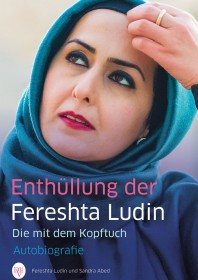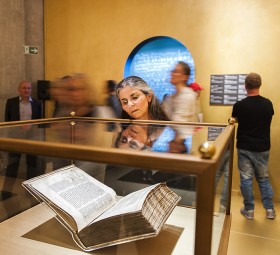Impressions of the “Obedience” Exhibition, from Muslim and Christian Perspectives
During the recent “Long Night of Museums” event, visitors were given a unique introduction to our current temporary exhibition “Obedience. An Installation in 15 Rooms by Saskia Boddeke & Peter Greenaway,” when the imam Emine Erol and the pastor Silke Radosh-Hinder led guided tours together. We asked the two women what they made of the occasion, and whether the joint guided tours had opened up novel views and perspectives on the biblical story.
Ms Erol, Ms Radosh-Hinder, would each of you describe the exhibition in your own words?
Silke Radosh-Hinder: For me, the exhibition is above all an opportunity to examine the story of the Binding of Isaac from a myriad of perspectives.
Emine Erol: The primary focus of the Obedience exhibition is the frame of mind of Ismael/Isaak respectively of his father Abraham. By prompting an emotional response and reflection, it helps visitors understand, ultimately, that such surrender may be dangerous or possibly even fatal—and also to understand what may motivate it. → continue reading
A Conversation with Fereshta Ludin about the Headscarf Debate, Discrimination, and Her Hopes for the Future.
To win the right to work as a teacher in the classroom while wearing her headscarf, Fereshta Ludin had to go all the way to the German Supreme Court (see below). On 17 September 2015, she will join us as part of the series “New German Stories” to introduce her book Enthüllung der Fereshta Ludin. Die mit dem Kopftuch (“The Unveiling of Fereshta Ludin: The One with the Headscarf”). Rafiqa Younes and Julia Jürgens spoke with her in the lead-up to the event.

Book cover © Deutscher Levante Verlag
Ms. Ludin, did you ever guess that the first lawsuit you filed against your employers, in 1998 when you were 25 years old, would set off a nationwide debate about the headscarf ban?
You can’t really imagine something like that. I was still very young and idealistic. I wanted to work as a teacher and had no intention of provoking the public or any politicians.
From your perspective, was it worth it to go all that way through courts, becoming, as you did, a public figure – “the one with the headscarf” as the title of your book ironically references?
I don’t regret a single step along the way. I would have regretted much more, to have had to endure the injustice. I took an active stand against discrimination by going through the courts. Many other women were also affected. It was never my aim to become a public person. → continue reading
A Conversation about the Exhibition “Obedience”
The exhibition “Obedience. An Installation in 15 Rooms by Saskia Boddeke & Peter Greenaway,” which has just been extended for two months, prompts extremely varied visitor responses. Atalya Laufer and Marc Wrasse regularly give guided tours of the exhibition. They talked to me recently about the experiences they’ve had, how they see the exhibition, and what they believe is at the root of visitors’ reactions.
Mirjam Wenzel: What form do your guided tours of the exhibition take?

Visitor in the “Golden Room” with manuscripts of the three monotheistic religions © Jewish Museum Berlin, photo: Jule Roehr
Marc Wrasse: We don’t so much guide visitors as accompany them on a three-step journey of discovery. We welcome the group and give a brief introductory talk, during which we point out that the Museum commissioned two artists to create the exhibition. Then, together with the visitors, we read aloud the relevant passage of the Bible—incidentally, the translation by Moses Mendelsohn—before leaving them to the exhibition.
Atalya Laufer: I prefer to use the translation by Martin Buber and Franz Rosenzweig.
Marc: But you too use roleplay, do you not, when reading the Bible story? That way, we make it clear that we want to explore the exhibition with our visitors and enjoy a shared experience. → continue reading

